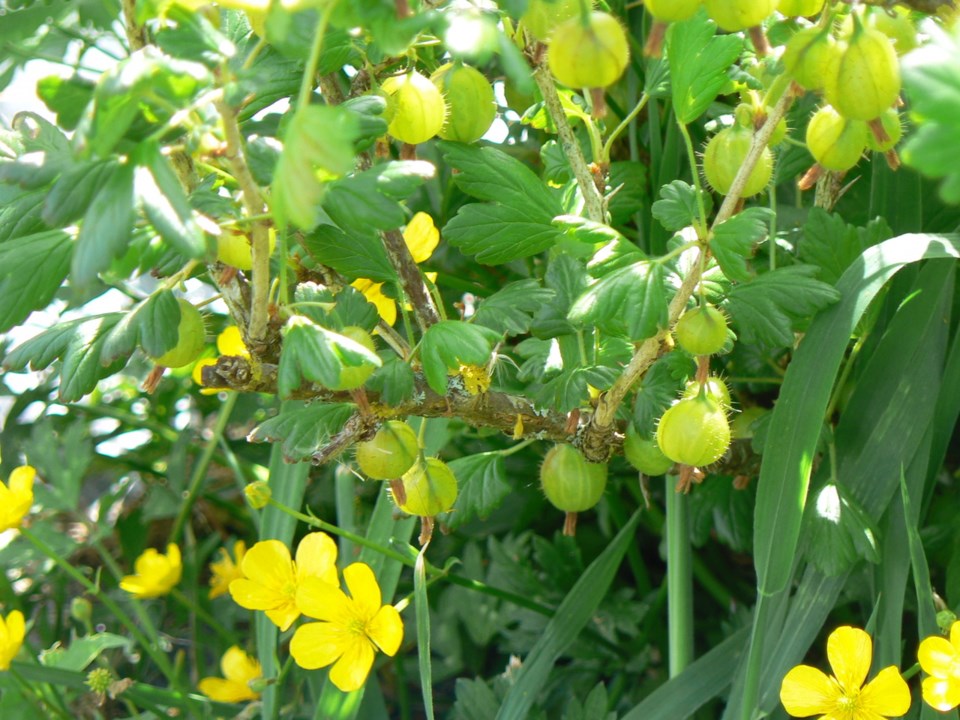Gooseberries have the largest fruit of the Ribes grown on the prairies, generally about 2 cm in diameter, similar to the size of grapes.
• 'Captivator' is thornless with red, pear-shaped fruit of good flavour that is larger than other varieties and very sweet.
• 'Hinnomaki Red' has flavourful red fruit good for both fresh eating and processing. It is thorny and somewhat sprawling and not as productive as other varieties.
• 'Pixwell' has medium-sized, pale green fruit which becomes pink when ripe. Its long pedicels and relatively few thorns make picking easier. It is productive, hardy and a consistent producer.
• 'Poorman' has pear-shaped, dark wine-red berries with excellent flavour. It is resistant to grey mould and mildew.
Planting and Care
Plant all Ribes species in early spring, spacing them about five feet apart. They do better in clay soils with a high organic matter content. If you garden on sand, add lots of compost, well-rotted manure and peat moss to increase your soil's moisture-holding capacity.
Ribes prefer shade for part of the day. In full sun, ensure that they have consistent moisture. Golden currants are adapted to full sun. To conserve moisture and control weeds, mulch currants and gooseberries to a depth of four inches to about 1 m beyond their drip line.
Avoid tilling as their roots are very shallow. Because of their shallow root systems, they are best fertilized with a top dressing of very well composted manure in early spring before growth begins. Alternatively, apply a granular fertilizer at a level much less than generally recommended. Their shallow root systems quickly take up nutrients and are easily "burned" by nitrogen. They compete poorly with nearby plants that have aggressive root systems.
Prune them in early spring before growth begins. Branches 3 years or older have generally reached the end of their productive years. Begin pruning at the base, as close to soil level as possible. Remove the oldest, thickest branches. By "opening up" the interior to sunlight and air movement, insect and disease habitat is reduced while flower production is increased, resulting in a higher yield of larger, tastier and better quality fruit.
Never remove more than 25% of a shrub's total volume. As well, avoid simply "shearing" the exterior of a shrub. The plant responds by developing multiple new stems at the point of every cut, in effect, creating a "hedge" at the end of every sheared point. Instead of allowing sunlight and air penetration to the interior, you have further blocked it.
Powdery mildew is the most common problem encountered with Ribes. Select a resistant variety and plant them at the recommended spacing. Pests include aphids, fruit flies and spider mites.
Harvest
Currants and gooseberries are usually ready for harvest from late July to early August. When picked, the stems remain attached at one end and sometimes the pistil and the dried flower are on the other end. Rub these off before eating or processing. Golden currants and gooseberries are very tasty to eat fresh but because of all the extra rubbing needed for each berry, many people prefer to process them for juice. Black and red currants contain hard seeds that make juicing them a good idea. Some people prefer to boil, mash and then process the fruit through a food mill to extract the juice. The berries improve in sweetness and flavour if allowed to remain on the bushes for two or three weeks after ripening.
And don't forget the ice cream, eh?
Sara Williams is the author and coauthor of many books including Creating the Prairie Xeriscape, Gardening Naturally with Hugh Skinner and, with Bob Bors, the recently published Growing Fruit in Northern Gardens. She continues to give workshops on a wide range of gardening topics throughout the prairies.
This column is provided courtesy of the Saskatchewan Perennial Society (SPS; [email protected] ). Check our website (www.saskperennial.ca) or Facebook page (www.facebook.com/saskperennial) for a list of upcoming gardening events




